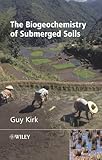The biogeochemistry of submerged soils/ Guy Kirk
Material type: TextPublication details: London: John Wiley & Sons, 2004Description: viii, 291 p. : ill., maps ; 24 cmISBN: 9780470863039Subject(s): Soil chemistry | Biogeochemistry | Hydromorphic soilsDDC classification: 631.41
TextPublication details: London: John Wiley & Sons, 2004Description: viii, 291 p. : ill., maps ; 24 cmISBN: 9780470863039Subject(s): Soil chemistry | Biogeochemistry | Hydromorphic soilsDDC classification: 631.41 | Item type | Current library | Call number | Status | Date due | Barcode | Item holds |
|---|---|---|---|---|---|---|
|
|
Central Library, Sikkim University General Book Section | 631.41 KIR/T (Browse shelf(Opens below)) | Available | P08389 |
Preface
Acknowledgements
1 Introduction
1.1 Global Extent of Submerged Soils and Wetlands
1.2 Biogeochemical Characteristics
1.3 Types of Submerged Soil
1.3.1 Organic Soils
1.3.2 Mineral Soils
1.3.3 Relation between Soils and Landform
2 Transport Processes in Submerged Soils
2.1 Mass Flow
2.2 Diffusion
2.2.1 Diffusion Coefficients in Soil
2.2.2 Propagation of pH Changes Through Soil
2.3 Ebullition
2.4 Mixing by Soil Animals
3 Interchange of Solutes between Solid, Liquid and Gas Phases
A. WATER
3.1 Composition of the Water
3.1.1 Acid and Bases
3.1.2 Speciation
3.1.3 Equilibrium Calculations
3.2 pH Buffer Capacity
3.3 Equilibrium with the Gas Phase
3.3.1 Floodwater CO2 Dynamics
3.4 Gas Transport Across the Air-Water Interface
3.4.1 CO2 Transfer Across the Air-Water Interface
B. SOIL
3.5 The Solid Surfaces in Soils
3.6 The Solid Surfaces in Submerged Soils
3.6.1 Organic Matter in Submerged Soils
3.7 Solid-Solution Interactions
3.7.1 Adsorption
3.7.2 Precipitation
3.7.3 Co-Precipitation in Solid Solutions
3.7.4 Inhibition of Precipitation
3.7.5 Equations for Solid—Solution Interactions
Reduction and Oxidation
4.1 Thermodynamics and Kinetics of Redox Reactions
4.1.1 Electron Activities and Free Energy Changes
4.1.2 Redox Potentials
4.1.3 Relation between pe and Concentration of Redox
Couples
4.1.4 pe-pH Diagrams
4.1.5 Energetics of Reactions Mediated by Microbes
4.2 Redox Conditions in Soils
4.2.1 Changes with Depth in the Soil
4.2.2 Changes with Time
4.2.3 Calculated Changes in pe, pH and Fe During Soil
Reduction
4.2.4 Measurement of Redox Potential in Soil
4.3 Transformations of Nutrient Elements Accompanying
Changes in Redox
4.3.1 Transformations of Carbon
4.3.2 Transformations of Nitrogen
4.3.3 Transformations of Sulfur
4.3.4 Transformations of Phosphorus
4.4 Oxidation of Reduced Soil
4.4.1 Kinetics of Fe^"^ Oxidation
4.4.2 Simultaneous Diffusion and Oxidation ;n Soil
Biological Processes in the Soil and Floodwater
5.1 Microbiological Processes
5.1.1 Processes Involved in Sequential Reduction
5.1.2 Nitrate Reduction
5.1.3 Iron and Manganese Reduction
5.1.4 Sulfate Reduction
5.1.5 Methanogenesis
5.1.6 Aerobic Processes
5.2 Macrobiological Processes
5.2.1 Net Primary Production and Decomposition
5.2.2 The Floodwater-Soil System
5.2.3 Floodwater Properties
5.2.4 Floodwater Flora
5.2.5 Fauna
5.3 Is Biodiversity Important?
6 Processes in Roots and the Rhizosphere
6.1 Effects of Anoxia and Anaerobicity on Plant Roots
6.1.1 Adaptations to Anoxia
6.1.2 Armstrong and Beckett's Model of Root Aeration
6.2 Architecture of Wetland Plant Root Systems
6.2.1 Model of Root Aeration versus Nutrient Absorption
6.2.2 Root Surface Required for Nutrient Absorption
6.3 Nutrient Absorption Properties of Wetland Plant Roots
6.3.1 Ion Transport in Roots
6.3.2 Ion Transport in Wetland Roots
6.4 Root-Induced Changes in the Soil
6.4.1 Oxygenation of the Rhizosphere
6.4.2 The pH Profile Across the Rhizosphere
6.5 Consequences of Root-induced Changes
6.5.1 Nitrification-Denitrification in the Rhizosphere
6.5.2 Solubilization of Phosphate
6.5.3 Solubilization of Zinc
6.5.4 Immobilization of Cations
6.6 Conclusions
7 Nutrients, Toxins and Pollutants
7.1 Nutrient and Acidity Balances
7.1.1 Nutrient Balances in Ricefields
7.1.2 Acidity Balances in Ricefields
7.1.3 Peat Bogs
7.1.4 Riparian Wetlands
7.1.5 Tidal Wetlands
7.2 Toxins
7.2.1 Acidity
7.2.2 Iron Toxicity
7.2.3 Organic Acids
7.2.4 Salinity
7.3 Trace Elements
7.3.1 Global Cycling of Trace Elements
7.3.2 Transport Through Soil and into Plant Roots
7.3.1 Mobilities of Individual Trace Elements
8 Trace Gases
8.1 Methane
8.1.1 Global Budget
8.1.2 Processes Governing Methane Emissions from Rice
8.1.3 Modelling Methane Emission
8.1.4 Estimating Emissions at the Regional Scale
8.1.5 Possibilities For Decreasing Emissions
8.2 Nitrogen Oxides
8.2.1 Global Budget
8.2.2 Processes Governing Nitrous and Nitric Oxide
Emissions from Rice
8.2.3 Differences between Rice Production Systems
8.3 Ammonia
8.3.1 Global Budget
8.3.2 Processes Governing Ammonia Emissions from Rice
8.4 Sulfur Compounds
8.4.1 Global Budget
8.4.2 Emissions from Ricefields
8.5 Carbon Sequestration
References
Index


There are no comments on this title.